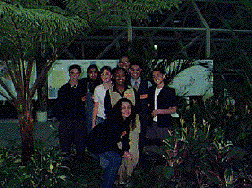BE THE VOICE OF THE VOICELESS, CAPPATO SAYS TO CANADIAN
YOUTH
By Regina Flores, TG Magazine Youth
Journalist

It is common for youth to be concerned and active only
with local environmental issues that directly pertain to them.
Naturally, some feel disconnected and distanced from efforts
across the globe because the relevance of the problem is not as
clear or vivid as the problems they confront in their own
community. How can Canadian youth bridge the gap that separates
international youth efforts concerning the environment around the
world? Why is it important to do so? These are questions Canadian
youth journalists explored this week.
Support from Canadian youth is essential to stop the destruction
of the environment, according to Jorge Cappato, Executive Director
of Fundacion Proteger for sustainable development and health (and
member of the Global 500 Forum and Argentinean member of
IUCN).
Youth in Argentina are protesting the planned construction of a
mega-project that would have serious, detrimental ecological
effects in addition to negative social, economic and health
impacts, he said. Youth both from the region being affected and
from other areas further away are involved in trying to save
Panara, Cappato said. Students from a number of schools, mostly at
the elementary level and usually a group of more than 1000, gather
in what is known as "encuentros regionales de jovenes," or
regional youth meetings where discussions can occur and efforts
can be united.
The youth from the "de la Costa" (from the coast) community do not
have the mechanisms to deliver their message internationally.
Therefore, Cappato says that North American youth must "be the
voice of the voiceless," because it is in North America that the
crucial decisions regarding many mega development projects are
made. In the case of Panara, the technology and materials needed
for the undertaking are controlled in the United States,
therefore, the connection of interests is clear. Youth can push
for media attention and put political pressure on authorities of
corporations and government officials, he said.
Cappato stressed that it is in our best interest to help save this
area which contains more than 300 fish species, and 250 bird
species. In addition, rare species from the Amazon migrate to this
area to reproduce in certain seasons. Conservation of biodiversity
is a global issue and should be a global effort, he says.

Jacquie Manchevsky from Environment Canada, raised a
similar point in saying that partnerships in efforts to protect
and clean up the environment are critical because of the
interconnectedness of environmental issues.
Even if Canadian youth are making efforts to clean up their
environment, they must realize that at the end of the day they
still share the air they breathe, the water they drink and the
resources they need with the rest of the world. The state of the
Panara region will ultimately affect Canadian youth.
According to Parvis Hassan of the IUCN Environmental Law
Commission, youth play an important role in providing support for
each other in terms of education and communicating messages. He
said that educated youth especially, have an obligation to
disadvantaged youth who are struggling with poverty and
illiteracy, to educate them about their rights and inform them of
their power to demand change in the environmental arena. It is the
duty of the urban population to support the rural communities and
to help them develop their agenda of environmental priorities, he
said.
Manchevsky says establishing ties between youth from "developed"
and "developing" countries is an important step to creating the
global village needed to address environmental issues.
She thinks that international conferences such as the IUCN
Congress provide important opportunities for youth to share their
experiences and learn about those of others. Furthermore, with
today's existing technology, some youth can set up international
communication links quite easily. Ms. Manchevsky pointed out that
in many underdeveloped areas, youth do not have immediate access
to such technology. However, projects to expand services to reach
isolated areas are in the works. With E-mail, Canadian youth will
be able to remain in contact with youth involved in the Panara
River project . TG Magazine's web site on the internet
(www.tgmag.ca) has allowed youth observers during the Congress to
voice their concerns about environmental issues across the
country.
In this way, Quebecers can inform others about the plight of the
St.Lawrence beluga whales, while Ontario youth can debate the
Temagami issue and Nova Scotians can expose the Fundy Park issue.
Eventually, if we tap into a global network, the youth from Panara
Medio in Argentina can transmit their message as well.
Perhaps schools might even begin to incorporate more sophisticated
methods in the future such as video conferencing. We must continue
to look for such venues that allow for "global generations" to
exchange of ideas, the planning of events and the enrichment of
knowledge in order for youth efforts to grow beyond regional
protests into effective international action and change....
Back to home page...


